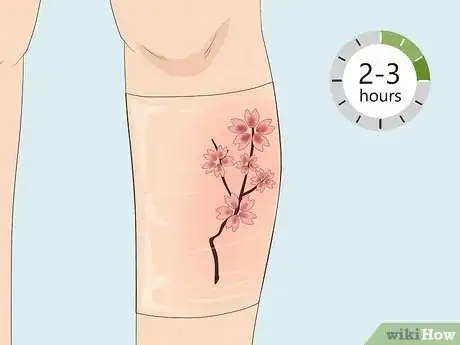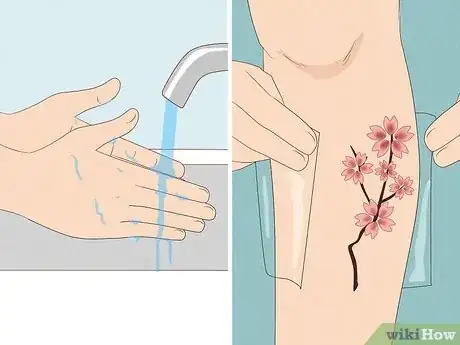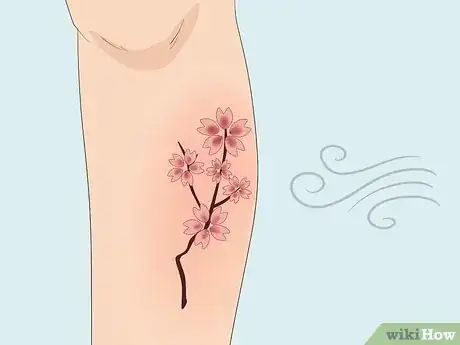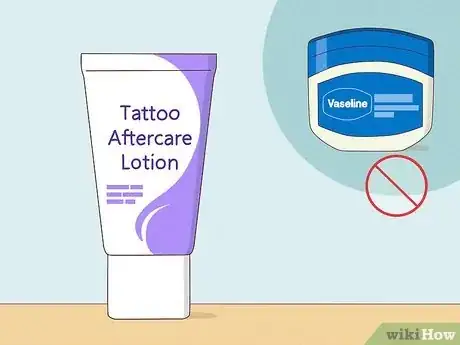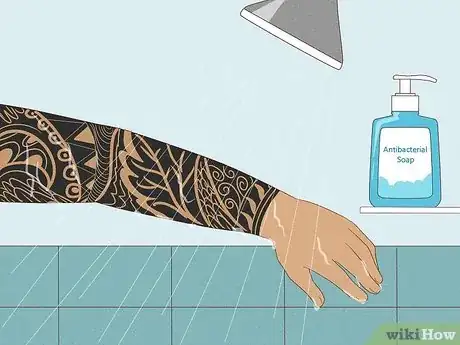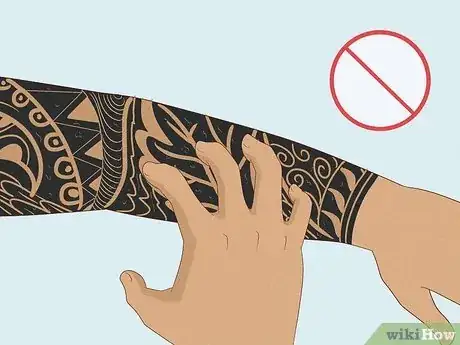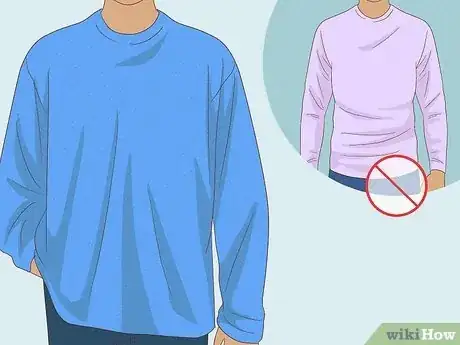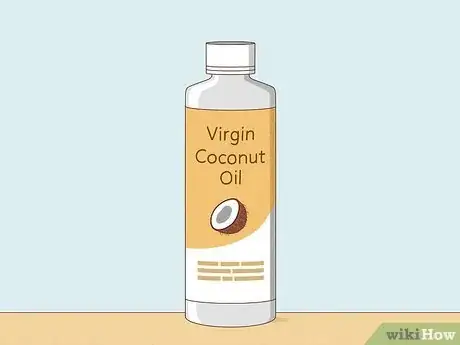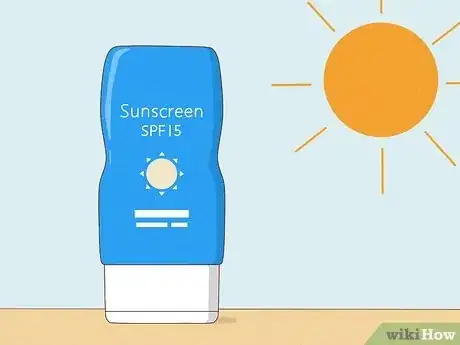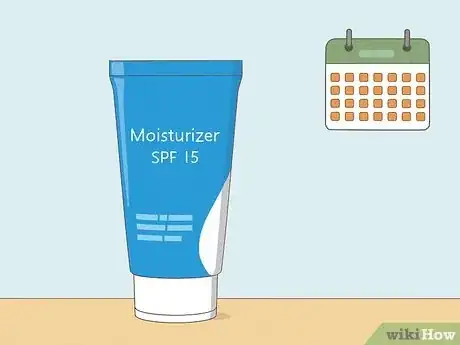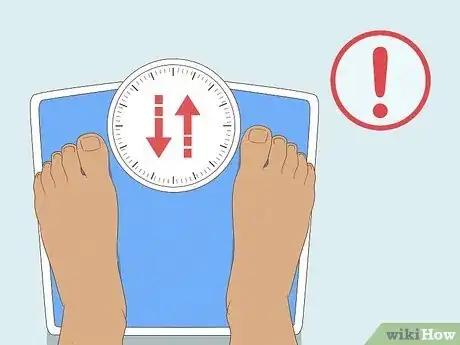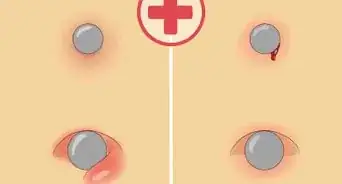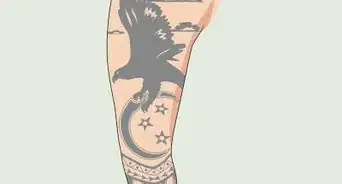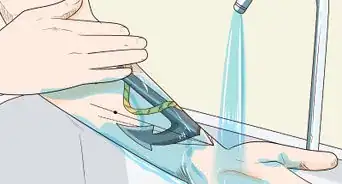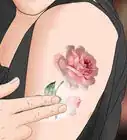This article was co-authored by Michelle Myles and by wikiHow staff writer, Nicole Levine, MFA. Michelle Myles is the Co-owner of Daredevil Tattoo, a tattoo shop located based in New York City's Lower East Side. Michelle has more than 20 years of tattooing experience. She also operates the Daredevil Tattoo Museum, co-owner Brad Fink's personal collection of antique tattoo memorabilia that he has amassed over the last 27 years of tattooing.
There are 12 references cited in this article, which can be found at the bottom of the page.
wikiHow marks an article as reader-approved once it receives enough positive feedback. This article has 339 testimonials from our readers, earning it our reader-approved status.
This article has been viewed 8,755,240 times.
Your new tattoo is not only a work of art, but also a medical procedure. Fortunately, caring for your new tattoo is simple, and you may already have the skincare products you'll need to heal your tattoo beautifully. To make sure your tattoo heals properly and stays vibrant over time, you'll need to keep it clean, moisturized, and out of direct sunlight. This wikiHow guide will teach you everything you need to know about tattoo aftercare, including helpful healing tips, choosing the right aftercare products, and keeping your tattoo looking great long-term.
Things You Should Know
- After unwrapping your new tattoo, clean the area with lukewarm water and unscented antibacterial soap, and allow it to air-dry.
- Apply an unscented moisturizer 2 to 3 times per day for the first two weeks or longer as recommended by your tattoo artist.
- To prevent fading over time, drink plenty of water, continue moisturizing your skin, and protect your tattoo from direct sunlight.
Steps
The First Day
-
1Leave the covering on for 2-3 hours or as directed by your tattoo artist. Once your tattoo is complete, your tattoo artist will clean the area, apply an antibacterial ointment, and cover the tattoo with a bandage or plastic. Resist the temptation to uncover your tattoo right away, as it is there to protect your tattoo from dirt and bacteria.[1]
- Since different tattoo artists have different methods of wrapping new tattoos, ask your tattoo artist when they recommend removing the bandage. Some artists may not wrap the tattoo at all, depending on the products and technique they use.
- If you leave the bandage on longer than the artist suggests, you are more prone to infection and the ink may bleed.
-
2Wash your hands before carefully removing the bandage. Having clean hands will help prevent infection.
- To remove the bandage more easily, you can apply warm water to it to prevent the bandage from sticking to your skin.
- Pull the bandage off slowly and carefully so you don't damage your new tattoo.[2]
Advertisement -
3Wash the tattoo with lukewarm water and antibacterial soap. Instead of submerging your tattoo, cup your hands together and scoop lukewarm water over it. Use a mild, hypoallergenic liquid antibacterial or antimicrobial soap to rub the tattoo gently with your fingers, removing all traces of blood, plasma, or leaked ink. This will help to prevent the tattoo from scabbing too soon.[3]
- Do not use a washcloth, loofah or any sponge to clean the tattoo, as these may harbor bacteria. Do not resume use of the items until the tattoo has healed completely.
- Avoid holding the tattoo directly under the water—the stream of water from the faucet may be too harsh on your new tattoo.
-
4Let the tattoo air dry or pat it dry. While it's best to let your skin air dry after the tattoo has been cleaned, you can also use a clean, dry paper towel to gently blot the tattoo until it's dry. Avoid rubbing the tattoo with the paper towel to avoid irritating your skin.[4]
- Regular towels can irritate your tattoo or cause little bits of fluff to get stuck in them, so it's best to only use a paper towel for drying.
-
5Apply a non-scented moisturizing cream or balm. Once your tattoo is fully dry, apply a little moisturizing cream, preferably a gentle tattoo aftercare product or fragrance-free lotion to the tattoo. Make sure to apply only a very thin layer and pat it in gently until it's absorbed by the skin. If you're not sure what kind of moisturizer to use, ask your tattoo artist what they recommend for your skin.[5]
- Don't use petroleum-based products, such as Vaseline or Neosporin, as these are too heavy and may clog the pores.
- Once your tattoo is clean and moisturized, avoid rewrapping it.
-
6Listen to your tattoo artist's advice. Your tattoo artist will explain how you should care for your tattoo immediately after getting it, so try to follow their instructions. The way they bandage your tattoo may be different from other tattoo artists, so take the advice they give you seriously to ensure your tattoo heals correctly.[6]
- Write down the instructions they give you on a piece of paper or type them up on your phone so you don't forget.
Healing Your Tattoo
-
1Wash and moisturize your tattoo daily until the scabs are gone. You should continue to wash your tattoo 2-3 times a day with antibacterial soap and lukewarm water until it's fully healed. This can take anywhere from 2 to 6 weeks, depending on the size and location of the tattoo.[7]
- While moisturizing is important, be careful not to smother the tattoo in lotion or ointment—a thin layer is all you need.
- Continue using an unscented mild soap when washing.
-
2Avoid scratching or picking at your tattoo. As it heals, your tattoo will start to scab over, which is normal. Let the scabs dry out and fall off by themselves, and don't speed up the process by picking or scratching at the scabs. This can cause the scabs to fall off too soon, which can leave holes or light spots on the tattoo.[8]
- Dry, scabbing or peeling skin can become very itchy, but scratching at your tattoo may also cause scabs to fall off.
- Keep using moisturizing ointment to combat itchiness if it is a problem.
-
3Keep your tattoo out of direct sunlight. The harsh rays of the sun may cause your skin to blister and bleach some of the colors from your tattoo. For this reason, it is best to keep your tattoo covered and away from the sun for at least 3 to 4 weeks until the initial healing is complete.[9]
- Once your tattoo is healed, you'll want to wear sunscreen to prevent the tattoo from fading.
-
4Avoid soaking the tattoo in water. Until your tattoo is fully healed, don't swim in a pool or the ocean. Avoid soaking in the bathtub or hot tub as well. Exposing your tattoo to lots of water can pull the ink out of your skin and do damage to the tattoo's appearance. The water may also be carrying dirt, bacteria, or other chemicals that can infect your tattoo.[10]
-
5Wear clean, loose-fitting clothing to avoid irritating your tattoo. Try not to wear tight or restrictive clothing on the area with your new tattoo, especially at first. As your tattoo heals, it will seep plasma and excess ink, which may cause the clothing to stick to the tattoo. The clothing will then be painful to remove and may rip off any freshly formed scabs.[11]
- If your clothing does stick to your tattoo, do not pull! First wet the area with water, which should loosen the clothing to where it can be removed without damaging your tattoo.
- Tight clothing will prevent enough oxygen from getting to your tattoo, and oxygen is essential for the healing process.
-
6Wait for your tattoo to heal before doing strenuous workouts. If the tattoo covers a large surface area or is near your joints (such as elbows and knees), it may take longer to heal if the skin is forced to move too much during physical activity. The movement will cause the skin to crack and become irritated, prolonging the healing process.[12]
- If you work in a job that involves physical activity, such as construction or dance, you may want to consider having your new tattoo done right before you have a day or 2 off so it has time to heal before you return to work.
Long-Term Care
-
1Protect your tattoo from the sun. To prevent your tattoos from fading, avoid direct sunlight whenever possible. Always apply sunscreen to your tattoos any time you aren't able to protect them with clothing.
-
2Use moisturizer regularly. While you don't have to continue using the same products you did when you first got your tattoo, you'll want to make sure you're regularly moisturizing your skin to keep your tattoo looking bright and fresh. This is especially important when your tattoo is in an area that rubs against clothing or is regularly exposed to sunlight.
- Some moisturizers also include sun protection (SPF), which can be a convenient option for protecting your tattoo over time.
-
3Stay hydrated. Studies show that not drinking enough water can lead to dry and dehydrated skin.[15] To keep your tattoo looking vibrant, drink plenty of water every day.
-
4If possible, avoid rapid weight loss or gain. Changes in your body size can stretch or warp your tattoo. Gradual changes in body size won't make your tattoos look much different, but rapid changes can lead to noticeable distortions in your ink.
- Weight loss can make your tattoos look wrinkled due to excess skin. You can decrease these effects by increasing muscle tone as you lose weight.[16]
- Rapid weight gain, including through pregnancy, will likely lead to tattoo distortion. You can decrease these effects by staying hydrated, using oils like Bio-Oil to hydrate the skin, and toning the body with exercise.[17]
Quick Tips on Caring for a New Tattoo
Expert Q&A
Did you know you can get expert answers for this article?
Unlock expert answers by supporting wikiHow
-
QuestionWhat are tips for caring for my tattoo on the first day of getting it?
 Michelle MylesMichelle Myles is the Co-owner of Daredevil Tattoo, a tattoo shop located based in New York City's Lower East Side. Michelle has more than 20 years of tattooing experience. She also operates the Daredevil Tattoo Museum, co-owner Brad Fink's personal collection of antique tattoo memorabilia that he has amassed over the last 27 years of tattooing.
Michelle MylesMichelle Myles is the Co-owner of Daredevil Tattoo, a tattoo shop located based in New York City's Lower East Side. Michelle has more than 20 years of tattooing experience. She also operates the Daredevil Tattoo Museum, co-owner Brad Fink's personal collection of antique tattoo memorabilia that he has amassed over the last 27 years of tattooing.
Tattoo Artist & Co-owner, Daredevil Tattoo If your tattoo artist uses a clear plastic dressing, you'll typically leave that in place for a few days. However, if your artist uses a taped-on bandage, remove the bandage after a few hours and wash the tattoo, then apply a light coat of a non-greasy ointment. Don't use anything greasy like vitamin E, aloe, or petroleum jelly. If you're in doubt, follow the care sheet your tattoo artist gives you.
If your tattoo artist uses a clear plastic dressing, you'll typically leave that in place for a few days. However, if your artist uses a taped-on bandage, remove the bandage after a few hours and wash the tattoo, then apply a light coat of a non-greasy ointment. Don't use anything greasy like vitamin E, aloe, or petroleum jelly. If you're in doubt, follow the care sheet your tattoo artist gives you. -
QuestionWhat are recommendations to not irritate the tattoo as it heals?
 Michelle MylesMichelle Myles is the Co-owner of Daredevil Tattoo, a tattoo shop located based in New York City's Lower East Side. Michelle has more than 20 years of tattooing experience. She also operates the Daredevil Tattoo Museum, co-owner Brad Fink's personal collection of antique tattoo memorabilia that he has amassed over the last 27 years of tattooing.
Michelle MylesMichelle Myles is the Co-owner of Daredevil Tattoo, a tattoo shop located based in New York City's Lower East Side. Michelle has more than 20 years of tattooing experience. She also operates the Daredevil Tattoo Museum, co-owner Brad Fink's personal collection of antique tattoo memorabilia that he has amassed over the last 27 years of tattooing.
Tattoo Artist & Co-owner, Daredevil Tattoo
-
QuestionWhat advice would you give to someone who just got their first tattoo?
 Michelle MylesMichelle Myles is the Co-owner of Daredevil Tattoo, a tattoo shop located based in New York City's Lower East Side. Michelle has more than 20 years of tattooing experience. She also operates the Daredevil Tattoo Museum, co-owner Brad Fink's personal collection of antique tattoo memorabilia that he has amassed over the last 27 years of tattooing.
Michelle MylesMichelle Myles is the Co-owner of Daredevil Tattoo, a tattoo shop located based in New York City's Lower East Side. Michelle has more than 20 years of tattooing experience. She also operates the Daredevil Tattoo Museum, co-owner Brad Fink's personal collection of antique tattoo memorabilia that he has amassed over the last 27 years of tattooing.
Tattoo Artist & Co-owner, Daredevil Tattoo
Warnings
- Avoid washing your new tattoo with hot water.⧼thumbs_response⧽
- Don't shave the tattoo until it's fully healed. If you shave around it, make sure you don't get shaving cream on the tattoo to avoid irritating it.⧼thumbs_response⧽
- Do not leave the bandage/plastic wrap on for more than 3 hours.⧼thumbs_response⧽
References
- ↑ https://uhs.umich.edu/bodyart
- ↑ https://www.eadv.org/cms-admin/showfile/Tattoo%20Aftercare.pdf
- ↑ https://wexnermedical.osu.edu/blog/how-to-care-for-a-new-tattoo
- ↑ https://uhs.umich.edu/bodyart
- ↑ https://www.mskcc.org/cancer-care/patient-education/instructions-after-nipple-areola-tattoo
- ↑ https://wexnermedical.osu.edu/blog/how-to-care-for-a-new-tattoo
- ↑ https://www.jucm.com/tattoos-and-piercings-what-the-urgent-care-provider-needs-to-know/
- ↑ https://www.eadv.org/cms-admin/showfile/Tattoo%20Aftercare.pdf
- ↑ https://www.aad.org/public/everyday-care/skin-care-basics/tattoos/tattoo-skin-reactions
- ↑ https://www.mskcc.org/cancer-care/patient-education/instructions-after-nipple-areola-tattoo
- ↑ https://www.jucm.com/tattoos-and-piercings-what-the-urgent-care-provider-needs-to-know/
- ↑ https://patient.uwhealth.org/education/after-care-instructions-for-permanent-tattooing
- ↑ https://www.aad.org/public/everyday-care/skin-care-basics/tattoos/caring-for-tattooed-skin
- ↑ https://inkedritual.com/blogs/news/4-natural-oils-to-moisturize-your-tattoos
- ↑ https://www.ncbi.nlm.nih.gov/pmc/articles/PMC4529263/
- ↑ https://www.jobydorr.com/blog/2021/5/30/tattoos-and-weight-loss-everything-you-need-to-know
- ↑ https://authoritytattoo.com/tattoos-after-gaining-weight/
About This Article
Caring for a new tattoo properly will help prevent an infection and keep your tattoo looking bright and clear. After you get your tattoo, your tattoo artist should apply a layer of petroleum jelly and a clear bandage over it. According to Inked Magazine, you should leave this bandage on for several hours or overnight to protect your skin from bacteria and keep it from rubbing against something. Then, wash your hands, remove the bandage, and gently wash your tattoo with antibacterial soap and water. Pat the area dry, then apply a layer of antibacterial ointment or petroleum jelly to it. Let your skin breathe and don’t apply another bandage. For the next three weeks, continue to wash your tattoo once or twice a day with antibacterial soap, and apply a thin layer of ointment after each wash. Avoid submerging your tattoo in water until it’s fully healed. Don’t worry if your tattoo scabs or flakes, which is normal. However don't scratch or pick at your tattoo, since this could lead to scarring and cause the design to fade. If your skin shows sign of infection, like redness, warmth, pain, and leaking pus, visit your doctor. For tips on keeping your tattoo safe when you exercise or go outside, read on!
